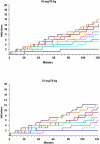Regulation of cocaine self-administration in humans: lack of evidence for loading and maintenance phases
- PMID: 20005893
- PMCID: PMC2824073
- DOI: 10.1016/j.pbb.2009.12.005
Regulation of cocaine self-administration in humans: lack of evidence for loading and maintenance phases
Abstract
Background: In rodents, cocaine self-administration under a fixed-ratio schedule and with timeout intervals limited to the duration of the infusions is characterized by an initial burst of drug intake (loading) followed by more stable infusion rates (maintenance). We sought to examine whether similar phases might characterize self-regulated cocaine use in humans.
Methods: 31 Non-treatment seeking, cocaine dependent subjects participated in three (8, 16, and 32 mg/70 kg/infusion), self-regulated, 2-h cocaine self-administration sessions under a fixed-ratio 1, 5-min timeout schedule. Data were assessed for visual (e.g., by graphs of cumulative numbers of infusions) and statistical evidence of change in phase (by step-function analyses of individual infusion rates).
Results: Graphs of cumulative infusions over time suggested a single, linear rate of self-administration over 2h at each cocaine dose. Statistical analyses of infusion data by generalized estimating equation (GEE) models also failed to support a loading/maintenance pattern (suggesting, if anything, the possibility of increasing infusion rates over time).
Conclusions: Our findings fail to support the existence of distinct loading and maintenance phases of self-regulated cocaine administration in humans at behaviorally relevant doses. Several factors may account for these observations including differences between humans and rodents in self-regulated drug intake.
(c) 2010 Elsevier Inc. All rights reserved.
Figures





References
-
- Carroll ME, Bickel WK. Behavioral-Environmental Determinants of the reinforcing functions of cocaine. In: Higgins S, Katz JL, editors. Cocaine abuse: basic determinants, cllinical applications, and policy New York Plenum. 1998. pp. 81–105.
-
- de la Garza R, Bergman J, Hartel CR. Food deprivation and cocaine self-administration. Pharmacology, biochemistry, and behavior. 1981;15:141–144. - PubMed
-
- Donny EC, Bigelow GE, Walsh SL. Choosing to take cocaine in the human laboratory: effects of cocaine dose, inter-choice interval, and magnitude of alternative reinforcement. Drug and alcohol dependence. 2003;69:289–301. - PubMed
-
- Ettenberg A, Pettit HO, Bloom FE, Koob GF. Heroin and cocaine intravenous self-administration in rats: mediation by separate neural systems. Psychopharmacology. 1982;78:204–209. - PubMed
-
- Fischman MW. Relationship between self-reported drug effects and their reinforcing effects: studies with stimulant drugs. NIDA research monograph. 1989;92:211–230. - PubMed
Publication types
MeSH terms
Substances
Grants and funding
- R01 DA012283/DA/NIDA NIH HHS/United States
- K02 DA000397/DA/NIDA NIH HHS/United States
- R01 DA015857/DA/NIDA NIH HHS/United States
- UL1RR024139/RR/NCRR NIH HHS/United States
- R25 MH071584/MH/NIMH NIH HHS/United States
- DA12283/DA/NIDA NIH HHS/United States
- DA018978/DA/NIDA NIH HHS/United States
- K24 DA017899/DA/NIDA NIH HHS/United States
- DA00397/DA/NIDA NIH HHS/United States
- DA15857/DA/NIDA NIH HHS/United States
- R01 DA011744/DA/NIDA NIH HHS/United States
- UL1 RR024139/RR/NCRR NIH HHS/United States
- T32 MH019961/MH/NIMH NIH HHS/United States
- R03 DA018978/DA/NIDA NIH HHS/United States
LinkOut - more resources
Full Text Sources

